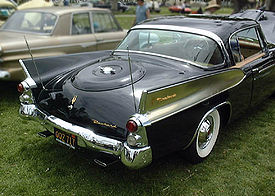
Packard Hawk
Encyclopedia

Packard
Packard was an American luxury-type automobile marque built by the Packard Motor Car Company of Detroit, Michigan, and later by the Studebaker-Packard Corporation of South Bend, Indiana...
production,. Packard's plant in Detroit, Michigan
Detroit, Michigan
Detroit is the major city among the primary cultural, financial, and transportation centers in the Metro Detroit area, a region of 5.2 million people. As the seat of Wayne County, the city of Detroit is the largest city in the U.S. state of Michigan and serves as a major port on the Detroit River...
had been leased to Curtiss-Wright
Curtiss-Wright
The Curtiss-Wright Corporation was the largest aircraft manufacturer in the United States at the end of World War II, but has evolved to largely become a component manufacturer, specializing in actuators, aircraft controls, valves, and metalworking....
(and would be soon sold to them), and Packard models in this dying-gasp year were all rebadged and retrimmed Studebaker products. The 1958 Packard Hawk was essentially Studebaker's 1957 Golden Hawk 400 with a fibreglas front end and a modified deck lid.
Instead of the Studebaker Hawk's upright Mercedes-style grille, the Packard Hawk had a wide, low opening just above the front bumper and covering the whole width of the car. Above this, a smoothly sloping nose, and hood—reminiscent of the 1953 Studebakers, but with a bulge as on the Golden Hawk—accommodated the engine's McCulloch supercharger
Paxton Automotive
Paxton Automotive is a United States-based manufacturer of superchargers for automotive use. The company is the major proponent of the centrifugal type supercharger. Early products were offered under the McCulloch name. Some Paxton superchargers have been factory fitted, but most units sold have...
that gave the Studebaker 289 in³ (4.7 L) V8 a total of 275 bhp (205 kW). At the rear, the sides of the fins were coated in metallized PET film
PET film (biaxially oriented)
BoPET is a polyester film made from stretched polyethylene terephthalate and is used for its high tensile strength, chemical and dimensional stability, transparency, reflectivity, gas and aroma barrier properties and electrical insulation.A variety of companies manufacture boPET and other...
, giving them a shiny metallic gold appearance. A fake spare-tire bulge adorned the 1953-53-style Studebaker deck lid. 'PACKARD' was spelled out in capitals across the nose, with a gold 'Packard' emblem in script—along with a Hawk badge—on the trunk lid and fins.
The interior was full leather, with a fully instrumentation in an engine-turned dash. As on early aircraft and custom boats, padded armrests were mounted outside the windows, a rare touch.

Its rarity and status as the best-regarded of the 'Packardbaker' final-year cars have made the Packard Hawk quite collectible. Values are roughly double those of the equivalent Studebaker, although they are still low by comparison with Corvettes and Thunderbirds. Because a Studebaker drivetrain was used, mechanical parts are more readily available, although body and trim parts are more difficult-to-impossible to find. While it is a unique car, current restoration costs almost always exceed the selling price.
Engine
Type: Cast iron 90° V8, Silver Lightdish-type pistons
Displacement: 289 cubic inches
Bore X stroke: 3.56 X 3.63 inches
Compression ratio: 7.5:1
Power @ rpm: 275 hp (205 kW) @ 4,800 RPM
Torque @ rpm: 333 lbft @ 3,200 RPM
Valvetrain: In-head valves, solid lifters
Main bearings: 5
Ignition: Delco-Remy breaker-point
Fuel system: 2-bbl Stromberg 380475 downdraft carburetor, McCulloch supercharger, 5 p.s.i. max
Lubrication system: Full-pressure, gear-driven
Electrical system: 12-volt, 30 amperes
Exhaust system: Cast iron, dual exhaust
Transmission
Type: Borg-Warner Flightomatic automaticRatios: 1st: 2.40:1
2nd: 1.47:1
3rd: 1.0:1
Reverse: 2.0:1
Differential
Type: Semi-floating hypoid, Twin-Traction Spicer-Thornton limited slipRatio: 3.31:1
Steering
Type: Power assist, Saginaw recirculating ballRatio: 19.2:1
Turns, lock-to-lock: 4.5
Turning circle: 41 feet
Brakes
Type: Four wheel, power-assist Wagner hydraulicFront: Cast-iron finned drum, 11 X 2.5 inches
Rear: Cast-iron drum, 10 X 2 inches
Swept area: 172.8 square inches
Chassis & Body

Body style: Two-door, five passenger hardtop, soft top prototype
Layout: Front engine, rear-wheel drive
Suspension
Front: Individual unequal-length upper and lower control arms, coil springs, hydraulic shocks, anti-sway barRear: Live axle, semi-elliptic leaf springs, hydraulic shocks
Wheels & Tires
Wheels: Kelsey-Hays tubeless 5-lug stamped steelFront/rear: 5.5 X 14 inches
Tires: Classic bias-ply
Front/rear: 8.00 X 14 inches
Weights & Measures
Wheelbase: 120.5 inchesOverall length: 205.2 inches
Overall width: 71.3 inches
Overall height: 54.6 inches
Front track: 56.7 inches
Rear track: 55.7 inches
Shipping weight: 3,470 pounds
Capacities
Crankcase: 5 quartsCooling system: 17 quarts
Fuel tank: 18 gallons
Transmission: 19 pints
Performance
0-60 mph: 12.0 seconds¼ mile ET: 16.7 seconds @ 82.3 mph
Top speed: 125 mph
Fuel mileage: 12 mpg city, 20 mpg highway
Sources
- Kimes, Beverly Rae (editor): Packard, a history of the motor car and the company; General edition, 1978, Automobile Quarterly, ISBN 0-915038-11-0.
- Dawes, Nathaniel D.: The Packard: 1942-1962; A.S. Barnes & Co. Inc., Cranbury NJ (1975), ISBN 0-498-01353-7
- Patrick, Mark A. (editor): Packard Motor Cars 1946-1958 Photo Archive; Iconographix Osceola WI (1996), ISBN 1-882256-45-X
- Clarke, R. M.: Packard Gold Portfolio 1946-1958; Motorbooks International, ISBN 1-870642-19-8
- Encyclopedia of American Cars from 1930 by the editors of Consumer’s Guide; Publications International (1993), ISBN 0-7853-0175-5
- Burness, Tad: American Car Spotter’s Guide, 1940-65; Motorbooks International, ISBN 0-87938-057-8
External links
- Packard Automobile Classics, Inc. - The Packard Club
- Packard Motor Car Information
- Homepage of the The National Packard Museum, Warren, Ohio, USA

